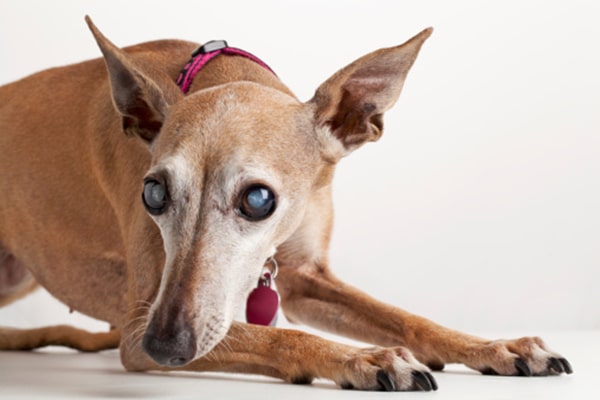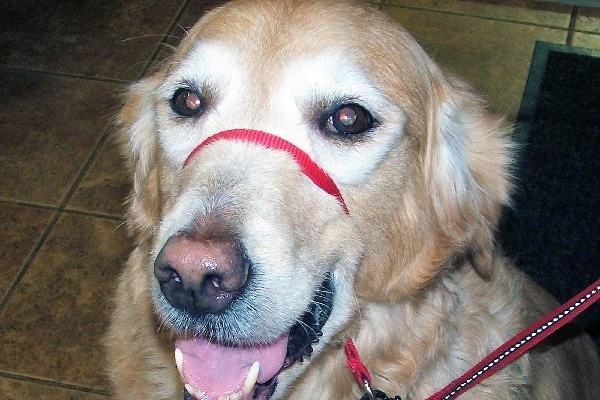Eventually, most dogs develop at least a few physical issues as they advance in years. It’s not unusual, for example, to begin noticing various types of vision changes. Pet parents who observe a milky-looking discoloration across one or both pupils may automatically assume that cataracts are the cause. But it’s also possible to encounter a very common condition — nuclear sclerosis in dogs. Here, we explain the key differences — and discuss various steps you can take to optimize your furry friend’s eye health.
Visiting the Vet: Initial Diagnosis

Does your dog have cataracts or nuclear sclerosis? Photography ©marekuliasz | Thinkstock.
Any time you notice a change in canine eye appearance, a veterinary specialist should evaluate the issue as a preliminary step. An ophthalmic exam can assess the outer layer of your dog’s eye, called the cornea. Your vet may also attempt to view the retina, which sits toward the back of the eye. Light is focused onto the retina from the lens, which is situated behind the light-bending cornea. On a very basic level, this process is what allows your canine’s eye to produce visual images.
My own dog’s retinal exam involved administering pupil-dilating drops, then using a special instrument called an ophthalmoscope to see inside the eye. Cataracts are an opacity within the lens itself, which can be caused by several factors. If your vet can’t see through this filminess, your dog probably can’t see much either. Unless professionally treated with surgery (or in certain cases, carnosine drops), cataracts can eventually rob a canine’s vision altogether.
Understanding Nuclear Sclerosis in Dogs: The Symptoms
Fortunately, cataracts aren’t always the culprit. Many dogs with eye cloudiness actually have a less-serious eye condition called nuclear sclerosis. Sometimes referred to as lenticular sclerosis, this condition often occurs as a result of simple aging.
Naturally present, tissue-based fibers begin crowding inward on the normally clear lens, gradually become denser. This explains why the most common symptom of nuclear sclerosis in dogs is a greyish-blue haze that can sometimes be mistaken for cataracts. According to veterinary ophthalmologists like Washington-based Northwest Animal Eye Specialists, nuclear sclerosis in dogs can begin as early as middle age (around six for most canines). Sometimes, however, it goes unnoticed until the hazy appearance becomes more pronounced.
There’s really no pain involved with nuclear sclerosis in dogs, and vision loss isn’t severe. Remember, canines largely depend on their superior sense of smell and hearing to navigate the world. “Most dogs with nuclear sclerosis get around fine,” notes Judy L. McBeth DVM, CVA of Fox Ridge Veterinary Clinic in Oswego, Illinois. “The change is so gradual that they adapt quite well,” she adds. “They may have more difficulty seeing in dim lighting, and probably don’t see fine details as well as before. This might present a problem for people — but since dogs don’t read or do needle point, it usually doesn’t bother them.”
Treatment & Lifestyle Options for Nuclear Sclerosis in Dogs
On the downside, there’s no medical treatment that can truly cure or prevent nuclear sclerosis in dogs. Similar to cataracts, the condition simply develops in certain animals. But you can still make things easier on your pet. For example, keep your home environment predictable and consistent. If dim lighting presents a challenge, switch on a nightlight at bedtime. If detail or depth perception becomes an issue, consider providing a helpful boost into the car, or onto a favorite chair.
Dr. McBeth also stresses the vital importance of diet for dogs with nuclear sclerosis. “You are what you eat,” she says, “so feed your pet a quality, grain-free diet.” She also recommends regular veterinary exams and fecal checks to ensure that your pup is worm-free. “Many intestinal worm larval stages can actually migrate through the eyes,” she explains.
It’s also worth noting that certain antioxidants, complementary therapies, and/or herbal supplements may theoretically delay or even discourage eye-related issues as your pet ages.
Options to help support overall visual health when dealing with nuclear sclerosis in dogs.

An example of nuclear sclerosis in one of Dr. McBeth’s patients, Blue. Photography courtesy Judy L. McBeth DVM, CVA. Photography used with permission.
Antioxidants to Help With Nuclear Sclerosis in Dogs
These can help eliminate free radicals in the body, and Dr. McBeth says they’re great for supporting eye health. Vision-friendly antioxidants include beta carotene, Vitamin C, Vitamin E, coenzyme Q10, lutein and zeaxanthin.
Ask a holistic veterinarian to recommend specific dosage combinations for your pet based upon weight, health status and life stage. In her own practice, Dr. McBeth says that she frequently recommends a product called Ocu-GLO, which contains a blend of grapeseed extract, lutein, omega-3, fatty acids and vitamins.
Acupuncture to Help With Nuclear Sclerosis in Dogs
On her website, holistic veterinarian and author Dr. Cathy Alinovi explains that the eye is surrounded by acupuncture points which may respond to gentle stimulation over time. She says that four key energy channels (often called meridians) start or end at the eye.
This means a trained acupuncturist can place needles far away from the eyes themselves, yet still potentially support eye health. Dr. McBeth notes that acupuncture can also help aging pets struggling with arthritis. Visit aava.org to find a qualified practitioner in your area.
Natural/Herbal Remedies to Help With Nuclear Sclerosis in Dogs

An example of nuclear sclerosis in one of Dr. McBeth’s patients, Emma. Photography courtesy Judy L. McBeth DVM, CVA. Photography used with permission.
Silymarin for Nuclear Sclerosis in Dogs
Derived from a flowering plant called milk thistle, this extract can help fortify and detoxify the liver. Because the liver acts as the body’s master cleanser and filter, it’s closely linked to immunity. “In Traditional Chinese Medicine (TCM), the liver and kidney are also responsible for eye health,” notes Dr. McBeth
You can purchase silymarin capsules from many health food stores. Break them open, and hide a tiny pinch of the powder in your dog’s daily meal.
Boswellia for Nuclear Sclerosis in Dogs
This resin is produced from the tree that shares its name — and various studies have shown its ability to help control inflammation in both pets and people. Again, reducing overall inflammation may indirectly support general eye health over time. Boswellia is normally sold in tablets, which can be trimmed down with a pill cutter and concealed in treats.
Bilberry for Nuclear Sclerosis in Dogs.
Derived from a dwarf shrub related to the blueberry, bilberry is an edible berry has antioxidant properties that may assist with eye disorders. Herbal medicine studies suggest that natural compounds called anthocyanosides and flavonoids can help improve capillary strength. In fact, these anthocyanosides also seem particularly attracted to the retina. This could explain why bilberry is considered beneficial for addressing nuclear sclerosis in dogs.
Eyebright for Nuclear Sclerosis in Dogs.
Also called euphrasia, compounds from this aptly-named flowering plant have been used for generations to help alleviate eye infections and discharge. Eyebright is often sold in drop form, and it’s a good staple to include in any canine eye-defense arsenal.
Zinc/Vitamin C for Nuclear Sclerosis in Dogs.
Speaking of eye drops, there are several commercial blends of Vitamin C and zinc that can help soothe ailing or overworked eyes. Products specifically formulated for canines are available on Amazon, and at various holistic pet supply stores. One example is Dr. Goodpet Eye-C. Simply follow the manufacturer’s directions on the label to determine dosing.
Goji Berry for Nuclear Sclerosis in Dogs.
Also known as wolfberry and derived from the lycium plant, this berry is a favorite of Dr. McBeth for supporting canine eye health. It can typically be purchased online, or at health food stores. “Some dogs find the dried berries very tasty,” she notes, “and will eat them like treats!”
The Bottom Line on Treating Nuclear Sclerosis in Dogs
Should you opt to try any of these supportive remedies, it’s always smart to introduce them gradually. Always consult with a holistic veterinarian for specific dosing recommendations and work up to the suggested amount over multiple days.
Also, remember that having nuclear sclerosis doesn’t make your dog immune to cataract development. So remain alert to eye appearance and behavioral changes in your pet over time. Your watchful care truly can help your furry friend see a brighter tomorrow.
Thumbnail: Photography ©kacoates | Thinkstock.
Read more about dog health on Dogster.com:
- Horner’s Syndrome in Dogs — Symptoms, Diagnosis and Treatment
- Can You Use Human OTC Eye Drops as Eye Drops for Dogs?
- How Long Does It Take for a Dog to Digest Food? (Plus, Other Dog Digestion Basics)
The post Understanding Nuclear Sclerosis in Dogs appeared first on Dogster.
No comments:
Post a Comment